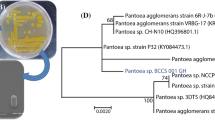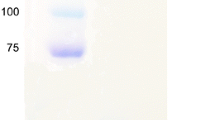Abstract
Polyglutamic acid (PGA), a protein in the mucilage of PGA-producing Bacillus spp., has expected applications in medical and biotechnological industries. Although the Bacillaceae family contains over 100 genera, research on bacterial PGA has exclusively focused on the genus Bacillus, especially B. subtilis var. natto and B. licheniformis. In the present study, indigenous Bacillaceae family strains were isolated from withered leaves and soil samples and screened for PGA production. As a result of the screening, the strain 8h was found to produce a mucilage possessing greater viscosity than PGA of B. subtilis var. natto (natto PGA). Biochemical analyses revealed that the 8h mucilage contains 63% protein and 37% polysaccharide, while mucilage of B. subtilis var. natto is composed of 61% protein and 39% polysaccharide. The most plentiful amino acid in 8h mucilage protein was glutamate (43%, mol/mol), which is similar to that of natto PGA, suggesting that it possesses characteristics of PGA. Although natto mucilage contains fructan, glucan was found as the polysaccharide of 8h mucilage. While phylogenetic studies indicated that the strain 8h belongs to Peribacillus simplex, the yield of the viscous mucilage by strain 8h was significantly higher than P. simplex type strain, suggesting that 8h is a mucilage-overproducing strain of P. simplex. Interestingly, 8h mucilage protein was found to contain more hydrophobic amino acid residues than natto PGA, suggesting that its amphiphilicity is suitable as a drug carrier and adjuvant. The present study is the first report of viscous mucilage and PGA-like protein produced by the genus Peribacillus.








Similar content being viewed by others
References
Ajayeoba TA, Dula S, Ijabadeniyi OA (2019) Properties of poly-γ-glutamic acid producing-Bacillus species isolated from ogi liquor and lemon-ogi liquor. Front Microbiol 10:771
Allioui N, Driss F, Dhouib H, Jlail L, Tounsi S, Frikha-Gargouri O (2021) Two novel Bacillus strains (subtilis and simplex species) with promising potential for the biocontrol of Zymoseptoria tritici, the causal agent of septoria tritici blotch of wheat. BioMed Res Int:6611657
Amann RI, Ludwig W, Schleifer KH (1995) Phylogenetic identification and in situ detection of individual microbial cells without cultivation. Microbiol Rev 59:143–169
Ashiuchi M, Nakamura H, Yamamoto T, Kamei T, Soda K, Park C, Sung MH, Yagi T, Misono H (2003) Poly-γ-glutamate depolymerase of Bacillus subtilis: production, simple purification and substrate selectivity. J Mol Cat B-Enzym 23:249–255
Ashiuchi M (2013) Microbial production and chemical transformation of poly-γ-glutamate. Microbial Biotechnol 6:664–674
Bajaj I, Singhal R (2011) Poly (glutamic acid) – an emerging biopolymer of commercial interest. Bioresource Technol 102:5551–5561
Bell DJ, Dedonder R (1954) A structural re-examination of the levans formed by Pseudomonas prunicola, Wormald, and Bacillus subtilis, BG2 F1. J Chem Soc 3:2866–2870
Berekaa MM, Abdel-Fattah YR, El-Sayed SM, El-Borai AM, El-Aassar SA (2006) Optimization of culture conditions for production of polyamide biopolymer (polyglutamate) by Bacillus sp. strain-R. J Biol Sci 6:687–694
Bovarnick M (1942) The formation of extracellular D-glutamic acid polypeptide by Bacillus subtilis. J Biol Chem 145:415–424
Branda SS, Gonzalez-Pastor JE, Ben-Yehuda S, Losick R, Kolter R (2001) Fruiting body formation by Bacillus subtilis. Proc Nat Acad Sci USA 98:11621–11626
Candela T, Moya M, Haustant M, Fouet A (2009) Fusobacterium nucleatum, the first Gram-negative bacterium demonstrated to produce polyglutamate. Can J Microbiol 55:627–632
Chamekh A, Kharbech O, Driss-Limam R, Fersi C, Khouatmeya M, Chouari R (2021) Evidences for antioxidant response and biosorption potential of Bacillus simplex strain 115 against lead. World J Microbiol Biotechnol 37:44
DuBois M, Gilles KA, Hamilton JK, Rebers PA, Smith F (1951) Colorimetric method for determination of sugars and related substances. Anal Chem 28:350–356
Halmschlag B, Putri SP, Fukusaki E, Blank LM (2020) Poly-γ-glutamic acid production by Bacillus subtilis 168 using glucose as the sole carbon source: a metabolomic analysis. J Biosci Bioeng 130:272–282
Ivanovics G, Bruckner V (1937) The chemical nature of the immuno-specific capsule substance of anthrax bacillus. Naturwissenschaften 25:250
Jiang L, Jung WY, Park SH, Kang SW, Lee MK, Lee JS, Lee JH, Lee J (2021) Draft genome sequence of Peribacillus sp. AGMB 02131 isolated from feces of a Korean cow. Korean J Microbiol 57:66–68
Kim E, Yang J, Sung MH, Poo H (2019) Oral administration of poly-gamma-glutamic acid significantly enhances the antitumor effect of HPV16 E7-expressing Lactobacillus casei in a TC-1 mouse model. J Microbiol Biotechnol 29:1444–1452
Kumar R, Vikramachakravarthi D, Pal P (2014) Production and purification of glutamic acid: a critical review towards process intensification. Chem Eng Process 81:59–71
Kwak C, Nguyen QT, Kim J, Kim TH, Poo H (2021) Influenza chimeric protein (3M2e-3HA2-NP) adjuvanted with PGA/Alum confers cross-protection against heterologous influenza a viruses. J Microbiol Biotechnol 31:304–316
Lane DJ (1991) 16S/23S rRNA sequencing. In: Stackebrandt E, Goodfellow M (eds) Nucleic acid techniques in bacterial systematics. John Wiley & Sons, Hoboken, pp 115–175
Luo Z, Guo Y, Liu J, Qiu H, Zhao M, Zou W, Li S (2016) Microbial synthesis of poly-γ-glutamic acid: current progress, challenges, and future perspectives. Biotechnol Biofuels 9:537
Meerak J, Iida H, Watanabe Y, Miyashita M, Sato H, Nakagawa Y, Tahara Y (2007) Phylogeny of γ-polyglutamic acid-producing Bacillus strains isolated from fermented soybean foods manufactured in Asian countries. J Gen Appl Microbiol 53:315–323
Morikawa M, Kagihiro S, Haruki M, Takano K, Branda S, Kolter R, Kanaya S (2006) Biofilm formation by a Bacillus subtilis strain that produces gamma-polyglutamate. Microbiol 152:2801–2807
Nguyen QT, Kwak C, Lee WS, Kim J, Jeong J, Sung MH, Yang J, Poo H (2019) Poly-γ-glutamic acid complexed with alum induces cross-protective immunity of pandemic H1N1 vaccine. Front Immunol 10:1604
Ogunleye A, Bhat A, Irorere VU, Hill D, Williams C, Radecka I (2015) Poly-γ-glutamic acid: production, properties and applications. Microbiol 161:1–17
Oguntoyinbo FA, Sanni AI, Franz CMAP, Holzapfel WH (2007) Phenotypic diversity and technological properties of Bacillus subtilis species isolated from okpehe, a traditional fermented condiment. World J Microbiol Biotechnol 23:401–410
Patel S, Gupta RS (2020) A phylogenomic and comparative genomic framework for resolving the polyphyly of the genus Bacillus: proposal for six new genera of Bacillus species, Peribacillus gen. nov., Cytobacillus gen. nov., Mesobacillus gen. nov., Neobacillus gen. nov., Metabacillus gen. nov. and Alkalihalobacillus gen. nov. Int J Syst Evol Microbiol 70:406–438
Rabodonirina S, Rasolomampianina R, Krier F, Drider D, Merhaby D, Net S, Ouddane B (2019) Degradation of fluorene and phenanthrene in PAHs-contaminated soil using Pseudomonas and Bacillus strains isolated from oil spill sites. J Environ Manag 232:1–7
Schwarz AR, Ortiz I, Maymon M, Herbold CW, Fujishige NA, Vijanderan JA, Villella W, Hanamoto K, Diener A, Sanders ER, DeMason DA, Hirsch AM (2013) Bacillus simplex—a little known PGPB with anti-fungal activity—alters pea legume root architecture and nodule morphology when coinoculated with Rhizobium leguminosarum bv. viciae. Agronomy 3:595–620
Sela M, Katchalski E, Gehatia M (1956) Multichain polyamino acids. J Am Chem Soc 78:746–751
Shih L, Chen LD, Wu JY (2010) Levan production using Bacillus subtilis natto cells immobilized on alginate. Carbohydr Polym 82:111–117
Shima F, Akagi T, Akashi M (2015) Effect of hydrophobic side chains in the induction of immune responses by nanoparticle adjuvants consisting of amphiphilic poly(γ-glutamic acid). Bioconj Chem 26:890–898
Sirisansaneeyakul S, Cao M, Kongklom N, Chaniga C, Shi Z, Chisti Y (2017) Microbial production of poly-γ-glutamic acid. World J Microbiol Biotechnol 33:173–180
Smith PK, Krohn RI, Hermanson GT, Mallia AK, Gartner FH, Provenzano MD, Fujimoto EK, Goeke NM, Olson BJ, Klenk DC (1985) Measurement of protein using bicinchoninic acid. Anal Biochem 150:76–78
Song J, Kim S, An JH, Sang MK, Weon HY (2020) Complete genome sequence of Peribacillus butanolivorans KJ40, a soil bacterium alleviating drought stress in plants. Korean J Microbiol 56:407–409
Tamura T, Stecher G, Peterson D, Filipski A, Kumar S (2013) MEGA6: Molecular Evolutionary Genetics Analysis version 6.0. Mol Biol Evol 30:2725–2729
Taniguchi M, Kato K, Shimauchi A, Ping X, Fujita KI, Tanaka T, Tarui Y, Hirasawa E (2005) Physicochemical properties of cross-linked poly-γ-glutamic acid and its flocculating activity against kaolin suspension. J Biosci Bioeng 99:130–135
Tanimoto H, Mori M, Motoki M, Torii K, Kadowaki M, Noguchi T (2001) Natto mucilage containing poly-γ-glutamic acid increases soluble calcium in the rat small intestine. Biosci Biotechnol Biochem 65:516–521
Yamazaki M, Miyazaki H, Sato S (1988) Separation behavior of sugars by TLC and its application to food analysis (in Japanese). Bunseki Kagaku 37:121–127
Yuan Y, Yan F, Chen Y, Jin C, Guo JH, Chai Y (2016) Poly-γ-glutamic acids contribute to biofilm formation and plant root colonization in selected environmental isolates of Bacillus subtilis. Front Microbiol 7:1811
Zeng W, Lin Y, Qi Z, He Y, Wang D, Chen G, Liang Z (2013) An integrated high-throughput strategy for rapid screening of poly(γ-glutamic acid)-producing bacteria. Appl Microbiol Biotechnol 97:2163–2172
Author information
Authors and Affiliations
Corresponding author
Ethics declarations
Ethics approval
Not applicable. This article does not contain data collected from humans or animals.
Competing interests
The authors declare no competing interests.
Additional information
Publisher's Note
Springer Nature remains neutral with regard to jurisdictional claims in published maps and institutional affiliations.
Rights and permissions
Springer Nature or its licensor holds exclusive rights to this article under a publishing agreement with the author(s) or other rightsholder(s); author self-archiving of the accepted manuscript version of this article is solely governed by the terms of such publishing agreement and applicable law.
About this article
Cite this article
Sato, S., Ichiyanagi, N., Sugiyama, K. et al. Production of polyglutamic acid-like mucilage protein by Peribacillus simplex strain 8h. Folia Microbiol 68, 101–113 (2023). https://doi.org/10.1007/s12223-022-01000-4
Received:
Accepted:
Published:
Issue Date:
DOI: https://doi.org/10.1007/s12223-022-01000-4




